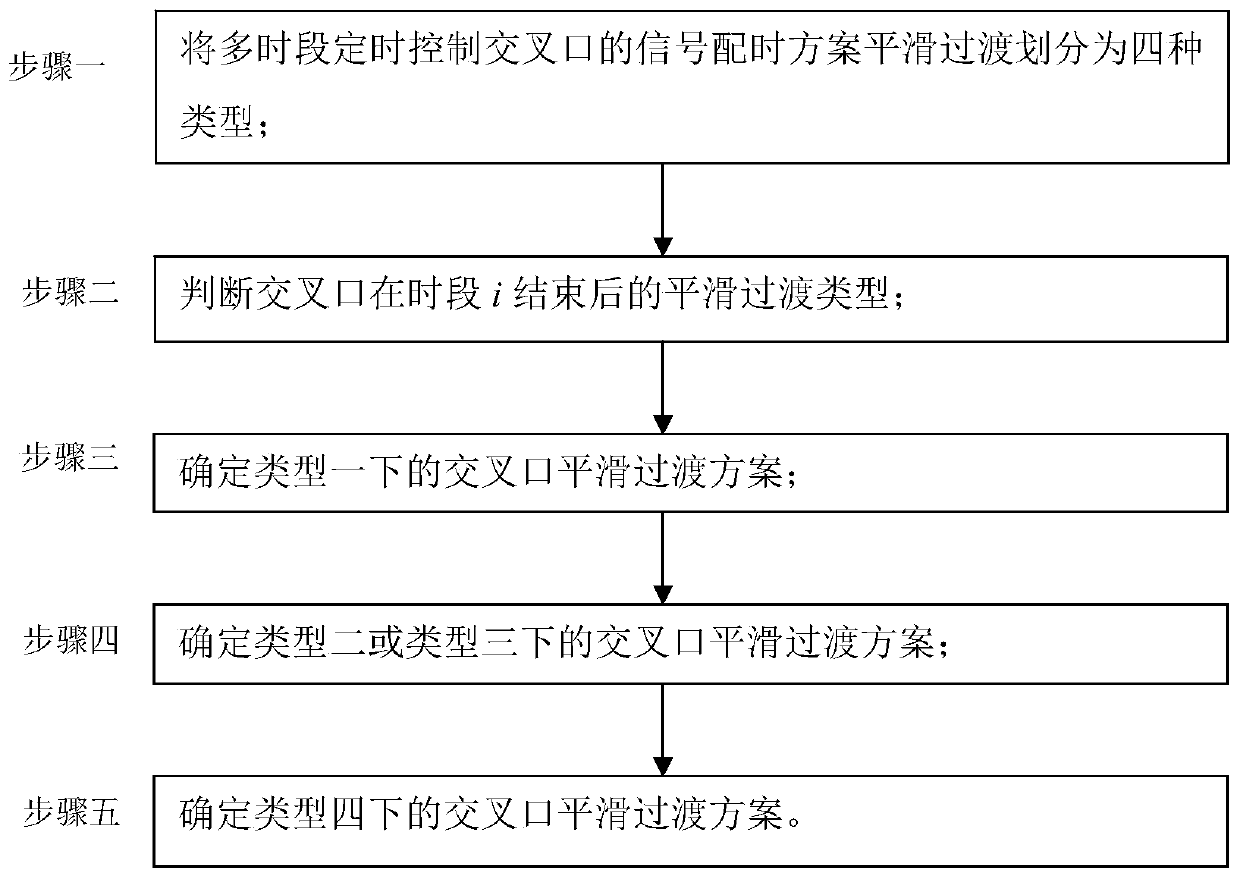Smooth transition method of intersection signal timing scheme under multi-time timing control
A smooth transition and timing control technology, applied in traffic control systems, traffic control systems of road vehicles, instruments, etc., to achieve fast and smooth transition, maintain stable operation, and improve real-time performance
- Summary
- Abstract
- Description
- Claims
- Application Information
AI Technical Summary
Problems solved by technology
Method used
Image
Examples
specific Embodiment approach 1
[0022] Specific implementation mode 1: The specific process of the smooth transition method of the intersection signal timing scheme under multi-period timing control in this implementation mode is as follows:
[0023] Step 1. Divide the smooth transition of signal timing schemes at multi-period timing control intersections into four types:
[0024] Type 1: In time period i and time period i+1, all the intersections involved are under single-point control;
[0025] Type 2: In time period i and time period i+1, all intersections involved are performing coordinated control;
[0026] Type 3: Single-point control is implemented at some intersections involved in period i, and coordinated control is implemented at other intersections; while coordinated control is implemented at all intersections in period i+1;
[0027] Type 4: Single-point control is implemented at some intersections involved in period i, and coordinated control is implemented at the remaining intersections; and si...
specific Embodiment approach 2
[0036] Specific implementation mode two: the difference between this implementation mode and the first implementation mode is that the smooth transition scheme of the intersection of the following type is determined in the step three; the specific process is:
[0037] Step 31. Let J equal to 1, where J is the number of intersections involved in period i or period i+1;
[0038] Step 32: Calculate the cycle duration of the intersection ρ in period i and the cycle duration at period i+1 the absolute value of the difference
[0039] Step three three, if Then, after the period i ends, the intersection ρ does not need to implement a smooth transition plan (suggested σ=30), and turns to step 3 and 5; otherwise, turns to step 3 and 4; σ is the threshold;
[0040] Step 3 and 4: After the period i ends, the intersection ρ needs to implement a smooth transition plan for one cycle;
[0041] The smooth transition scheme includes: the start time of the smooth transition scheme, the...
specific Embodiment approach 3
[0048] Specific implementation mode three: the difference between this implementation mode and the first or second implementation mode is: the start execution time of the smooth transition scheme in the step three or four The expression is:
[0049]
[0050] in: is the phase H of the running cycle of intersection ρ at the end of period i ρ (hereinafter referred to as "the end moment of the running cycle of intersection ρ at the end of period i") (for example, phase 1 is going straight north-south, phase 2 is turning north-south left, and the end time of the green light interval of phase 1 refers to The length of time between the end of the green light of phase 1 and the start of the green light of phase 2); H ρ is the phase number of intersection ρ;
[0051] Period duration of intersection ρ during smooth transition The expression is:
[0052]
[0053] Green time of phase h at intersection ρ during smooth transition The expression is:
[0054]
[0055] in: ...
PUM
 Login to View More
Login to View More Abstract
Description
Claims
Application Information
 Login to View More
Login to View More - R&D
- Intellectual Property
- Life Sciences
- Materials
- Tech Scout
- Unparalleled Data Quality
- Higher Quality Content
- 60% Fewer Hallucinations
Browse by: Latest US Patents, China's latest patents, Technical Efficacy Thesaurus, Application Domain, Technology Topic, Popular Technical Reports.
© 2025 PatSnap. All rights reserved.Legal|Privacy policy|Modern Slavery Act Transparency Statement|Sitemap|About US| Contact US: help@patsnap.com



